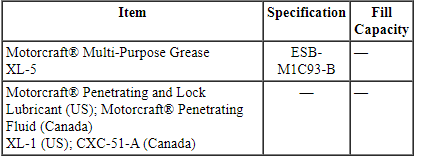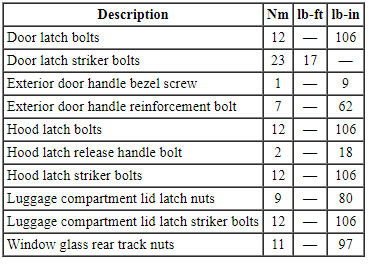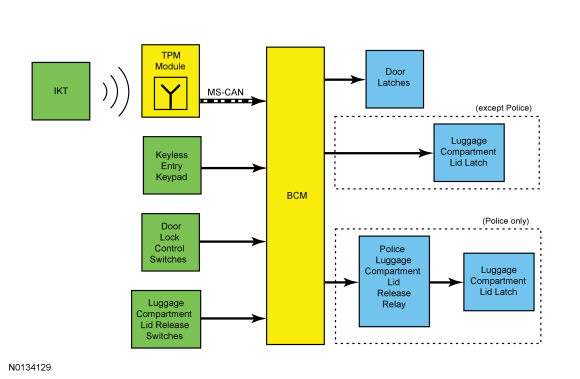SPECIFICATIONS
Material

Torque Specifications

DESCRIPTION AND OPERATION
Handles, Locks, Latches and Entry Systems
Overview
The power lock/unlock feature locks or unlocks the doors upon a customer request from either door lock control switch in the vehicle, a RKE transmitter, or the keyless entry keypad. The power door locking system functions independently of ignition status or vehicle speed.
System Operation
System Diagram

Network Message Chart
BCM Module Network Input Messages

Power Door Locks
The BCM controls the door locks by using a series of relays (driver door unlock/passenger doors unlock/all doors lock) integrated within it. When the relays are not energized, ground is provided on both circuits to the lock motors within the latches. When an unlock relay energizes, voltage is provided to one side of the lock motor to unlock the door(s). When the lock relay energizes, the polarity is reversed and the motors lock the doors.
NOTE: The door lock and the unlock relays are internal to the BCM and are non-serviceable.
The BCM sends voltage signals to the door lock control switches. When a door lock control switch is pressed, the voltage signal is routed to ground, indicating a request to lock/unlock the doors.
Based upon input from the door lock control switches, the RKE transmitter, and the keyless entry keypad, the BCM energizes the lock all relay, the unlock driver door relay or unlock all relay. When the all lock relay is energized, the BCM supplies voltage on the all door lock circuit and ground on the driver and passenger door unlock circuits. When the unlock driver door relay or unlock all relay is energized, the voltage and ground are reversed. When the lock and unlock relays are not energized, continuity to ground is supplied on all door lock actuator circuits. A dedicated BCM ground circuit is provided for the lock and unlock relays.
Luggage Compartment Lid Release
The BCM sends a voltage signal to the luggage compartment lid release switch. When the luggage compartment lid release switch is pressed, the voltage signal is routed to ground, indicating a request to release the luggage compartment lid latch. The BCM momentarily provides voltage to the luggage compartment lid latch to actuate the release motor.
The BCM releases luggage compartment lid only when the doors are unlocked electronically or when requested from the RKE system.
On vehicles with the police option, the BCM output passes through a police luggage compartment lid release relay prior to the luggage compartment lid latch.
When the relay is energized (ignition in RUN), the BCM output for the luggage compartment lid release voltage is routed directly to the luggage compartment lid latch.
When the relay is not energized (ignition in OFF/ACC), the BCM output for the luggage compartment lid release is routed to the ignition OFF bypass in-line connectors. If these are disconnected, voltage is prevented from reaching the luggage compartment lid latch. This configuration allows the luggage compartment lid release switch to operate only when the ignition is in RUN. Connecting the ignition OFF bypass in-line connectors bypasses this feature and allows the luggage compartment lid release to operate from the luggage compartment lid release switch when the ignition is OFF.
Keyless Entry Keypad
The BCM sends voltage signals on 3 separate circuits to the keyless entry keypad. When an individual keypad button is touched, an individual or combination of the input circuits is routed to ground. Based on these inputs, the BCM determines which button was touched and locks/unlocks the door(s) or opens the luggage compartment lid.
When a keypad button is touched, the buttons illuminate to provide better visibility. The keypad also illuminates any time the illuminated entry feature is active. If the lock all doors command is entered or 5 seconds have elapsed since the last button press, the keypad illumination turns off.
The keyless entry keypad can be used to:
- unlock the driver door.
- unlock all the doors.
- lock all the doors.
- program/erase the customer key code.
Vehicles equipped with a keypad are programmed with a 5-digit entry code. This code is provided to the customer through a wallet card in the Owner's Literature. In addition, this code is available through a scan tool and is printed on the BCM label. When entering codes, each digit must be entered within 5 seconds of the previous button press.
Locking the Doors with the Keyless Entry Keypad System
It is not necessary to enter the factory set or personal code prior to locking all doors. To lock all doors, touch and hold the 7/8 and 9/0 buttons at the same time for approximately 2 seconds.
Unlocking the Doors with the Keyless Entry Keypad System
To unlock the driver door, enter either the factory set code or a personal code (each digit must be pressed within 5 seconds of the prior digit). The illuminated entry feature activates unless disabled.
To unlock all doors, enter the factory set code or a personal code (driver door unlocks) and then touch the 3/4 button within 5 seconds. This feature can be changed to a 1-step unlock so that all of the doors unlock when a valid code is entered. REFER to Stepped Unlock Programming.
Anti-Scan Feature
To provide added security, the keypad is disabled for 1 minute after 35 button presses without a valid entry code being entered. The keypad flashes during this 1 minute mode with all functionality disabled except for 7/8 and 9/0 still being allowed to lock the vehicle.
Anti-scan turns off after 1 minute of keypad inactivity, the unlock button is pressed on a RKE transmitter, or the ignition is switched to RUN.
Factory Keycode Retrieval
The factory keycode for the keyless entry keypad can be retrieved from a label on the BCM, using a diagnostic scan tool, or by using 2 programmed keys.
To retrieve the factory keycode using 2 programmed keys:
- Place the first programmed key into the ignition lock cylinder or backup slot and turn the ignition on.
- Turn the ignition off and remove the first programmed key.
- Place the second programmed key into the ignition lock cylinder or backup slot and turn the ignition on.
The factory keycode displays momentarily in the message center.
Remote Keyless Entry (RKE)
The RKE system uses an IKT. The IKT incorporates both the PATS and the RKE transmitter functions in a single device.
In addition to the IKTs, 4 conventional keyfobs can also be programmed to the vehicle if requested by the customer. For programming the conventional keyfobs, REFER to Remote Keyless Entry (RKE) Transmitter Programming. The RKE transmitters can be used to:
- unlock the driver door.
- unlock all doors.
- lock all doors.
- open the luggage compartment lid latch.
- arm/disarm the perimeter alarm (if equipped).
- activate/deactivate the panic alarm.
- provide a visual confirmation when the unlock button is pressed (a long flash of the turn signals).
- provide an audible confirmation when the lock button is pressed twice within 3 seconds with all the doors closed (sounds the horn once).
- provide an audible confirmation when the lock button is pressed twice within 3 seconds and any door is ajar.
- remotely start the engine (if equipped with the factory remote start system).
The RKE transmitters have a normal operating range of 20 m (65.62 ft).
The RKE feature is controlled by the TPM module and the BCM. When a button is pressed on an IKT, the TIC and RKE command is received by the internal TPM module antenna. If the TPM module determines that it is a valid and programmed TIC, it sends the RKE command and TIC to the BCM over the MS-CAN. When the BCM receives the RKE data, it carries out the command by controlling the door locks or activating the horn or turn signals as required.
The RKE transmitters and the BCM also utilize a rolling code to prevent the code from being captured by a code grabber. The system advances the counter in the RKE transmitter and the BCM every time an RKE transmitter button is pressed.
RKE Transmitter Unlock
The RKE feature provides a stepped (if enabled) process for unlocking the doors. Upon receipt of the first request for unlocking the doors, the RKE control feature unlocks only the driver door and provides a long flash of the turn signals. If another unlock request is received within 3 seconds of the first, all the doors are unlocked. This feature can be disabled so that all the doors unlock on the first press of the unlock button. To enable/disable this feature, REFER to Stepped Unlock Programming.
RKE Transmitter Lock
The RKE feature requests that all of the doors lock when the lock button is pressed. On any press of the lock button with all doors closed, the doors lock and the turn signals flash once. If the hood, luggage compartment lid or any door is ajar, no flash occurs. As soon as the opening is closed, the turn signals flash.
If 2 presses of the lock button are received within 3 seconds, the horn chirps once and the turn signals flash twice to indicate that the hood, luggage compartment lid and all of the doors are closed and locked. If the hood, luggage compartment lid or any door is ajar when the second lock request is received within 3 seconds of the first, the RKE transmitter feature chirps the horn twice without flashing the turn signals to indicate it locked all of the doors but the hood, luggage compartment lid or a door is ajar. When the ignition is in ON, the turn signal flashes and horn chirp confirmations do not occur.
RKE Transmitter Luggage Compartment Lid Release
The RKE transmitter provides a luggage compartment lid release function. The luggage compartment lid button must be pressed twice within 3 seconds for the luggage compartment lid latch to release.
Panic Alarm
The panic alarm feature provides audible and visual alarms which are evident from the exterior of the vehicle. The panic alarm feature requests that the turn signals flash and the horn sounds until deactivation. The flashing of the outputs occurs simultaneously.
The panic alarm can only be activated when the ignition is OFF. This feature is disabled at all other times. Deactivation of an active panic alarm is accomplished when:
- a second press of the RKE transmitter panic button is detected.
- the ignition is switched out of OFF.
- a period of 2 minutes and 45 seconds have elapsed since the initial activation.
Remote Start (If Equipped)
The factory-installed remote start (if equipped), is controlled by a RKE transmitter and allows the engine to start from outside the vehicle. REFER to Section 303-06.
Autolock
The autolock feature locks all of the doors after all of the following have occurred:
- All the doors are closed
- The ignition is in RUN
- The vehicle is shifted into any gear (to put the vehicle in motion)
- The vehicle attains a speed greater than 20 kmh (12.4 mph)
The autolock feature repeats after all of the following have occurred:
- Any door is opened then closed while the ignition is in RUN and the vehicle speed is 15 kmh (9.3 mph) or lower
- The vehicle attains a speed greater than 20 kmh (12.4 mph)
The autolock feature can be enabled/disabled using the message center.
Auto-Unlock
NOTE: The doors do not auto-unlock if the vehicle has been electronically locked before the driver door is opened while the ignition is in OFF or ACC.
The auto-unlock feature unlocks all of the doors after all of the following have occurred:
- The ignition is in RUN, all the doors are closed and the vehicle has been in motion at a speed greater than 20 kmh (12.4 mph)
- The vehicle has come to a stop and the ignition is changed to OFF or ACC
- Within 10 minutes of the ignition changing to OFF or ACC, the driver door is opened
The auto-unlock feature can be enabled/disabled.
Smart Unlock
The smart unlock feature prevents the doors from electronically locking with the key in the ignition lock cylinder. When the BCM receives a lock command from a door lock control switch, and the key is in the ignition lock cylinder with one of the front doors open, the BCM commands the doors to unlock.
To override the smart unlock feature and intentionally lock the doors with the key in the ignition lock cylinder, close all doors and lock the vehicle using the keyless entry keypad or pressing the lock button on another programmed IKT, or lock the doors manually with the lock rod before closing the door.
Component Description
Door Lock Control Switches
The door lock control switches are single pole, double throw switches. They are supplied voltage signals from the BCM for the lock and unlock requests. When a switch is pressed to lock or unlock, the corresponding input circuit is routed to ground, indicating a request to lock or unlock the doors.
Door Latches
The door latches are sealed units and contain the door lock actuator and the door ajar switch. The door lock actuators operate in 2 directions, depending on the polarity of the voltage. The door latches can be lubricated, if needed. REFER to Latch Lubrication.
Luggage Compartment Lid Release Switch
The luggage compartment lid release switch is a momentary contact switch that supplies a ground signal to the BCM. When the luggage compartment lid release switch is pressed, the signal is routed to ground, indicating a request to the BCM to open the luggage compartment lid.
Luggage Compartment Lid Latch
The luggage compartment lid latch contains the luggage compartment lid release motor and the luggage compartment lid ajar switch. The luggage compartment lid latch release motor is momentarily supplied voltage by the BCM when a valid request to open the luggage compartment lid is detected.
Keyless Entry Keypad
The keyless entry keypad is a touch sensitive capacitive sensor. When a finger touches the keypad, it changes the capacitance of the sensor in the area of the finger touch. The keypad determines which area is touched and provides a ground signal to the corresponding voltage reference circuit(s). The keypad only works when touched with a finger. The keyless entry keypad may not work when gloves are worn. The gloves act as an insulator and do not allow the finger to change the sensor capacitance.
Integrated Keyhead Transmitter (IKT)
NOTE: The IKTs must have SA stamped on the keyblade. Conventional PATS keys must have HA or SA stamped on the keyblade.

The IKT incorporates both the PATS functions and the RKE transmitter functions in a single device.
During key programming procedures, the PATS and RKE transmitter ID of an IKT are both programmed.
Up to a maximum of 4 IKTs can be programmed. If more than 4 IKTs are programmed, INT KEY COULD NOT PROGRAM displays in the message center during the key programming procedure and the RKE function of that IKT is non-functional.
 Diagnosis and Testing
Diagnosis and Testing
Handles, Locks, Latches and Entry Systems
Special Tool(s)
Material
DTC Chart
Diagnostics in this manual assume a certain skill level and knowledge of
Ford-specific diagnostic practices. Refer to Di ...
Other materials:
Using summer tires
Safe operation of your vehicle requires that your tires are properly
inflated. Remember that a tire can lose up to half of its air pressure
without appearing flat.
Every day before you drive, check your tires. If one looks lower than the
others, use a tire gauge to check pressure of all tires ...
Removal and Installation
Generator - 2.0L GTDI
Removal
Disconnect the battery. For additional information, refer to Section
414-01.
Remove the upper Charge Air Cooler (CAC) pipe. For additional
information, refer to Intake Air System Components - Exploded View
in Section 303-12.
...
Specifications, Description and Operation, Diagnosis and Testing
SPECIFICATIONS
Material
DESCRIPTION AND OPERATION
Engine
NOTICE: When repairing engines, all parts must be contamination
free. If contamination/foreign material is present when repairing an engine,
premature engine failure may occur.
NOTE: Specifications show the expected minimum or max ...

